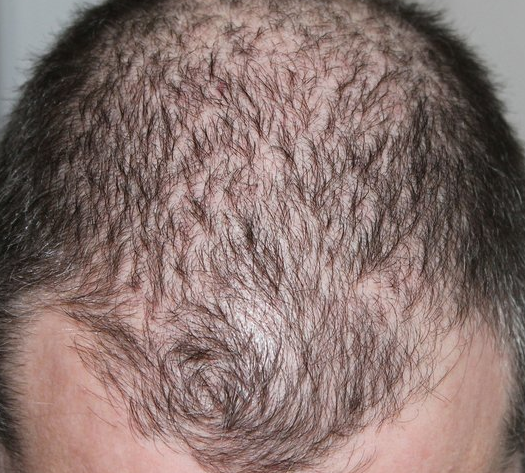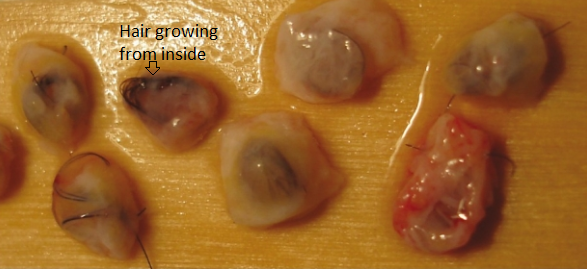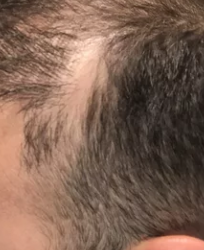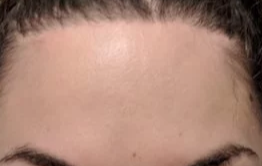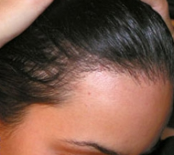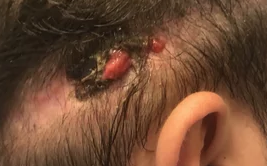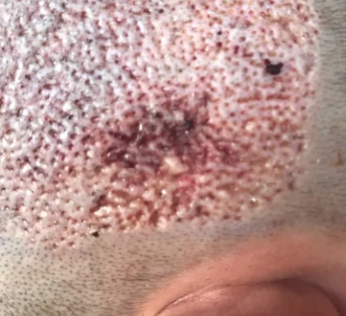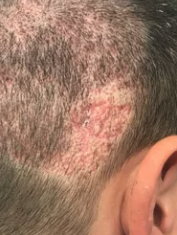No, there is no such evidence so far.
This sounds like a maturing hairline. While it is maturing, it is not unusual for one side to move up slightly ahead of the other side. It could also be an early recession, but at this stage, I would not worry about it. Just keep an eye on it. If you are really worried, see a doctor with a HAIRCHECK instrument to find out if there is any balding that you can’t visually see. (See here: https://baldingblog.com/value-haircheck-bulk-measurements-two-patients-seen-today/)
At day one, you run a risk with the use of hydrogen peroxide to clean the recipient area as it may get under the grafts and kill them. I recommend not using anything but soap and water.
The best thing you can do is see a doctor. It would help to see a picture of where your father’s balding pattern ended up. You are clearly thinning and the drug Finasteride can work miracles on 21 year-old men with your hair loss. Do not undergo a hair transplant under any circumstance as unethical doctors will offer you hair transplants to make a buck.
A rare side effect of finasteride is “brain fog” meaning that some people claim that they don’t think clearly. To my knowledge, this has never been reported as a permanent side effect.
The problem of those clinics is that they are doing like 15 patients per day. Most of those clinics are just hair mill, everything is rushed
You get to see the experienced surgeon only five minutes to draw you your hairline … He doens’t even answer your questions. People who are actually doing the FUE are inexperiencied technicians … The surgeon doesn’t do anything on your hair except drawing the line and trying to sell you useless vitamins ….
The surgeon even forced my friend to buy finasteride, he said you need to take finasteride for 1 week after the HT to make it succesful lol. They recruit new technician very often because the demand is so high, i went to turkey with a friend for his FUE, the technician said he started this week
The result my friend got is pretty bad, overharvested donor area, unnatural temples, pluggy hair, loft graft during operation, technician using snapchat during the operation etc … And he choosed one of the best “low cost” clinic in Turkey with a ton of “good reviews” So basically those clinics only show the good results or fake review …
Be careful, if FUE price in turkey is cheap, it’s for a reason
These lumps may be caused by buried grafts that were pushed under the skin of the donor area at the time the FUE was done. These, if they get infected or are painful, should be excised surgically. Here is an example of buried grafts that was removed after an FUE was incorrectly performed. If you look carefully at each lump, there are hairs and grafts inside the lumps.
I have a few follow up questions:
I am from Canada and am not sure if the local dermatologists will have this device. Are there any comparable alternatives?
If hair miniaturization and loss is caused by stress, even though I may have the hair loss gene, would decreasing stress stop or slow down the hair loss? (I am curious about this because through the observation of hair loss in my family, significant hair loss is nonexistent aside from one uncle on my dad’s side.)
Given my current description of hair loss, would you recommend medication such as finasteride and/or minoxidil or do you think a change in lifestyle should be the first line of defense?
Thank you in advance.
You do need to see a specialist to find out if you are losing hair. You have what appears to be a juvenile hairline in transition to a mature hairline. This is not balding. What I would do is perform a HAIRCHECK test to see if you are really losing hair. If you are, I would recommend finasteride and then follow your progress over a year to see if the hair loss was reversed by repeating the HAIRCHECK test. However, if you are not balding according to the HAIRCHECK test, then I would not recommend finasteride. Finasteride will not stop the movement from a juvenile to a mature hairline. (see: https://baldingblog.com/value-haircheck-bulk-measurements-two-patients-seen-today/)
Your final pattern of balding is what shows on the Norwood Classification Chart. That means that one of these patterns will be your final pattern. The older you are, the more certain you can be about your final pattern. If I am your doctor, I will perform yearly HAIRCHECK tests which will tell me well in advance what your final pattern might look like. For reasons I am not sure, other doctors don’t offer this service.
The pictures show that you were probably thinning in the area that is now devoid of hair, so the cause is likely due to the progression of the hair loss into the sides. Another hair transplant into this area will solve it; however, be careful that your doctor does not over-harvest your donor area or you will have a new problem – a see-through donor area with possible donor site depletion as shown many times in the RealSelf posts. Your donor density must be close to its harvested limit with an FUE procedure (assuming that you had an average donor density prior to your FUE transplant) so a strip surgery may be safer. You should make sure that your surgeon measures your donor density prior to making the recommendation for FUE or strip surgery.
You should have only single hairs in the first 4 mm of your frontal hairline or the hair transplant shows as a hair transplant. Your surgeon may not have put only single hairs there. A transition zone of single hairs is critical to make for a no-hairline hairline. This is what you should now do, see a surgeon that knows how to do this and have it placed in-front of your existing hairline and you will look better than normal.
The chart below shows that the scalp hair has the longest growth cycle of any hair on the body. That makes it the best hair for hair transplant. Beard comes in as a close second, but may not last as long for a growth cycle. Chest and hair on your back are very poor with a growth cycle such that only 30% of the hairs will be growinh at any one time. This is important information for those of you who have run out of scalp hair, and need hair from other sources. It is not good news
A typical female hairline is rounded and the leading edge should have a no-hairline hairline. This means that the transition zone should be built between your forehead and your thicker hairline so that there is no beginning of the hairline that looks like a ‘line’. Your picture on the left should be compared with a hair transplanted no-hairline hairline on the right below. Note the rounded soft nature of the hairline on the right which was completely transplanted, including the temple peaks and an advancement of the middle hairline about one inch, while the photo on the left is straight enough to draw a line connecting the hairs. I would build a transition zone with hair transplants to soften the abrupt hairline that is shown.
Page 304 of 635

